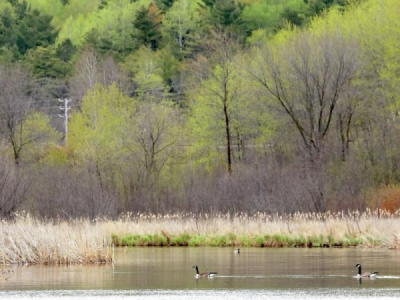
Posted on May 15, 2019
Work will begin in June on a massive cleanup project on the St. Louis River in Duluth, removing tons of wood waste from an old sawmill site at Grassy Point and removing flood-dumped sediment at the mouth of Kingsbury Creek.
The combined efforts will rehabilitate 240 acres total and cost more than $15 million and are part of the long-term effort to chip away at legacy pollution problems and habitat loss that has rendered the St. Louis River estuary on the list of toxic hotspots across the Great Lakes.
The projects, first outlined in the News Tribune in 2017, include removing 177,000 cubic yards of wood waste left by two 1890s-era sawmills.

The sheer amount of wood piled up at Grassy Point is staggering — an estimated half-million cubic yards. The wood waste, boards and chunks, are stacked 16 feet deep in some places. Some 177,000 cubic yards will be removed.
Much like Radio Tower Bay upstream, which was cleaned up in 2015 as part of the Great Lakes Restoration Initiative, the sawmill castoffs at Grassy Point are remarkably intact. All that wood has ruined the area as fish habitat, to be sure, but it’s a big part of Duluth history, when the city was briefly the lumber capital of the world. In one year alone, 1894, Duluth sawmills produced 343 million board feet of lumber. At Grassy Point, two sawmills built on stilts over the water — the LeSeur and St. Louis lumber companies — turned thousands of northwoods white pines that lumberjacks floated down the St. Louis River into millions of boards that helped build the cities of the Midwest.
Unfortunately the mills simply dumped the sawdust and waste wood into the river.
A mile and a half upstream, the Kingsbury Bay project will include the removal of 173,000 yards of excess sediment deposited there by Kingsbury Creek over years from upstream erosion — some of it from high on the Duluth hillside along Interstate 35 and some washed into the creek in the July 2012 flash flood.
That’s the equivalent of 14,416 big dump trucks full of sediment.
The Kingsbury project, adjacent to the city’s Indian Point Campground, will restore coastal wetland habitat, create open water and improve recreation for boaters and anglers. The clean sediment removed from Kingsbury Bay will be reused at Grassy Point to cap areas of wood waste that are not feasible to remove, create new land — upland habitat islands with native trees and plantings — and re-establish healthy aquatic plant and wildlife communities.
“The two projects could be done separately. But treating them as one large project creates efficiency in construction, allows us to reuse excavated soil and materials, and ultimately reduces the impacts for nearby neighborhoods,” said Melissa Sjolund, St. Louis River projects coordinator for the Minnesota Department of Natural Resources. “Together, they make one of the largest habitat restoration projects in DNR’s history.”
The projects should be wrapped up by September 2021, or earlier if possible.
The Kingsbury Bay and Grassy Point project areas were identified in 2013 as two of 17 sites located in the St. Louis River Area of Concern in need of habitat restoration. Three of the 17 projects already are completed.
Funding for the $15 million projects comes from the Minnesota Outdoor Heritage Fund, the federal Great Lakes Restoration Initiative with oversight by the U.S. Environmental Protection, and the St. Louis River/Interlake/Duluth Tar Superfund Site settlement.
The combined Kingsbury-Grassy Point project is the single largest so far in the Twin Ports under the Great Lakes Restoration Initiative. It’s all part of the effort to restore the lower St. Louis River — the headwaters of the Great Lakes and the largest freshwater estuary in North America — to a more natural state.
If you go
Kingsbury Bay/Grassy Point restoration project
Public information meeting
Tuesday, May 21 from 5-7 p.m.
City Center West Community Center/Evergreen Senior Center, 5830 Grand Ave. Duluth.
The Kingsbury Bay-Grassy Point project will restore 245 acres of open water, coastal wetlands and stream channels in two locations in the upper St. Louis Bay. DNR officials will be available to answer questions. For more information contact Melissa.Sjolund@state.mn.us or at 218- 302-3245.
Anyone interested in receiving project and construction updates should visit dnr.state.mn.us/st-louis-river-restoration.
Source: duluthnewstribune.com





